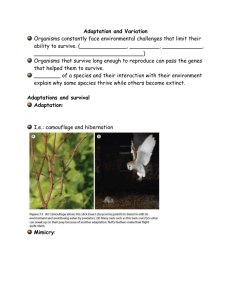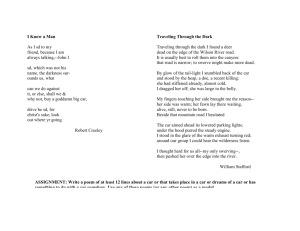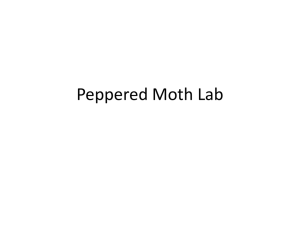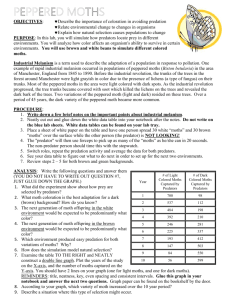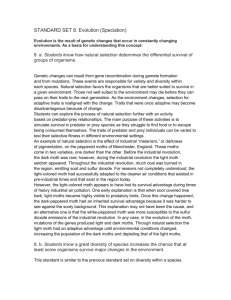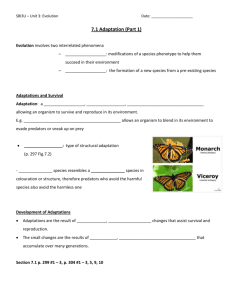Natural Selection
advertisement
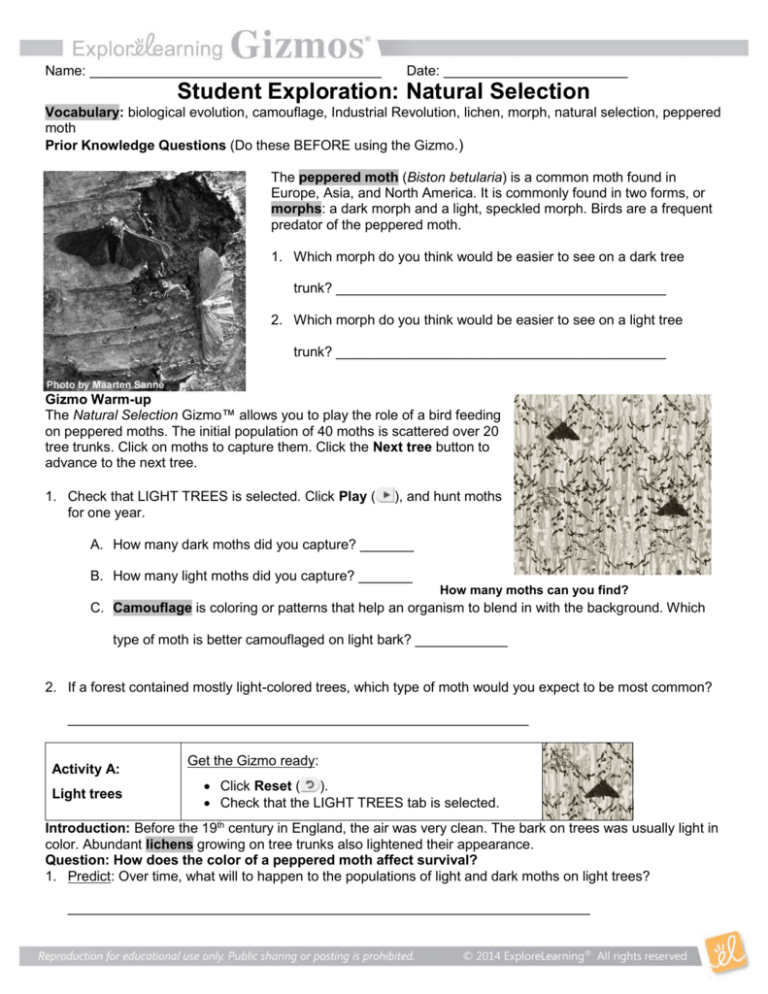
Name: ______________________________________ Date: ________________________ Student Exploration: Natural Selection Vocabulary: biological evolution, camouflage, Industrial Revolution, lichen, morph, natural selection, peppered moth Prior Knowledge Questions (Do these BEFORE using the Gizmo.) The peppered moth (Biston betularia) is a common moth found in Europe, Asia, and North America. It is commonly found in two forms, or morphs: a dark morph and a light, speckled morph. Birds are a frequent predator of the peppered moth. 1. Which morph do you think would be easier to see on a dark tree trunk? ___________________________________________ 2. Which morph do you think would be easier to see on a light tree trunk? ___________________________________________ Gizmo Warm-up The Natural Selection Gizmo™ allows you to play the role of a bird feeding on peppered moths. The initial population of 40 moths is scattered over 20 tree trunks. Click on moths to capture them. Click the Next tree button to advance to the next tree. 1. Check that LIGHT TREES is selected. Click Play ( for one year. ), and hunt moths A. How many dark moths did you capture? _______ B. How many light moths did you capture? _______ How many moths can you find? C. Camouflage is coloring or patterns that help an organism to blend in with the background. Which type of moth is better camouflaged on light bark? ____________ 2. If a forest contained mostly light-colored trees, which type of moth would you expect to be most common? ____________________________________________________________ Activity A: Light trees Get the Gizmo ready: Click Reset ( ). Check that the LIGHT TREES tab is selected. Introduction: Before the 19th century in England, the air was very clean. The bark on trees was usually light in color. Abundant lichens growing on tree trunks also lightened their appearance. Question: How does the color of a peppered moth affect survival? 1. Predict: Over time, what will to happen to the populations of light and dark moths on light trees? ____________________________________________________________________ 2. Experiment: Click Play and hunt peppered moths on light tree trunks for five years. In each year, try to capture as many moths as you can. After 5 years, select the TABLE tab and record the percentages of each moth type. (Note: The table shows current populations of each moth, not the number of captured moths.) Make a line graph of Number of Moths vs. Year. Plot the number of moths on the y-axis and the year on the x-axis. Use two different colors for the light-colored and the dark-colored. Don’t forget to label your axes and a title. Graph your data in the grid to the right of your table below. Year Dark moths Light moths 0 1 2 3 4 5 3. Analyze: What do your results show? _______________________________________________________ _____________________________________________________________________________________ 4. Apply: Which type of moth do you think was more common before the 19th century, when most trees were light in color? ________________________________________________________________________ 5. What is the independent variable?________________________________________________________ 6. What is the dependent variable?__________________________________________________________ 7. Examine the data in the table. Describe the trend you see in the numbers of light-colored moths as the decades passed. _____________________________________________________________________________ ____________________________________________________________________________________ 8. Examine the data in the table. Describe the trend you see in the numbers of dark-colored moths as the decades passed. _____________________________________________________________________________ ____________________________________________________________________________________ 9. Extend your thinking: What strategies did you use to hunt for moths? ______________________________ _____________________________________________________________________________________ _____________________________________________________________________________________ Activity B: Dark trees Get the Gizmo ready: Click Reset. Select the DARK TREES tab. Introduction: The 19th century was the time of the Industrial Revolution in England. Most of the new industries used coal for energy, and the air was polluted with black soot. In forests near factories, the soot coated trees and killed lichens. As a result, tree trunks became darker. Question: How did air pollution affect moth populations? 1. Predict: Over time, what will to happen to the populations of light and dark moths on dark trees? _____________________________________________________________________________________ 2. Experiment: Click Play and hunt peppered moths on dark tree trunks for five years. In each year, try to capture as many moths as you can. When you are done, select the TABLE tab and record the percentages of each moth type. Make a line graph of Number of Moths vs. Year. Plot the number of moths on the y-axis and the year on the x-axis. Use two different colors for the light-colored and the dark-colored. Don’t forget to label your axes and a title.Graph your data in the grid to the right of your table below. Year Dark moths Light moths 0 1 2 3 4 5 3. Analyze: What do your results show? _______________________________________________________ _____________________________________________________________________________________ 4. Apply: Which type of moth do you think was more common during the 19th century? Why? _____________________________________________________________________________________ _____________________________________________________________________________________ _____________________________________________________________________________________ 5. Draw conclusions: Natural selection is the process by which favorable traits tend to increase in frequency over time. How does this experiment illustrate natural selection? _____________________________________________________________________________________ _____________________________________________________________________________________ _____________________________________________________________________________________ _____________________________________________________________________________________ 6. Think and discuss: Did the changes you observed in the moth populations result from individual moths changing colors? Or did they occur because the best-hidden moths survived and reproduced, passing on their colors to their offspring? Explain your answer. _____________________________________________________________________________________ _____________________________________________________________________________________ _____________________________________________________________________________________ _____________________________________________________________________________________ 7. Extend your thinking: Biological evolution is the process by which populations of organisms change over time. How could natural selection lead to evolution? If possible, discuss your answer with your classmates and teacher. _____________________________________________________________________________________ _____________________________________________________________________________________ _____________________________________________________________________________________ _____________________________________________________________________________________ _____________________________________________________________________________________ 8. During the middle 1900’s, environmentalists really started voicing their concern about the harmful effects that industry was having on the environment. England and other countries started paying closer attention to cleaning up the environment by reducing emissions from industrial factories. These concerns helped to promote policies like the Clean Air Act in many countries. As these policies became implemented, new forms of energy started being used and industry was required to reduce emissions from their existing factories. What was the environmental impact of the Clean Air Act? _____________________________________________________________________________________ _____________________________________________________________________________________ _____________________________________________________________________________________ _____________________________________________________________________________________ _____________________________________________________________________________________ 9. How do you think the Clean Air Act impacted the number of light and dark colored moths? _____________________________________________________________________________________ _____________________________________________________________________________________ _____________________________________________________________________________________ _____________________________________________________________________________________ _____________________________________________________________________________________ 10. What are some other ways that you think humans may influence the evolution of organisms? Explain why you think this way. _____________________________________________________________________________________ _____________________________________________________________________________________ _____________________________________________________________________________________ _____________________________________________________________________________________ _____________________________________________________________________________________



